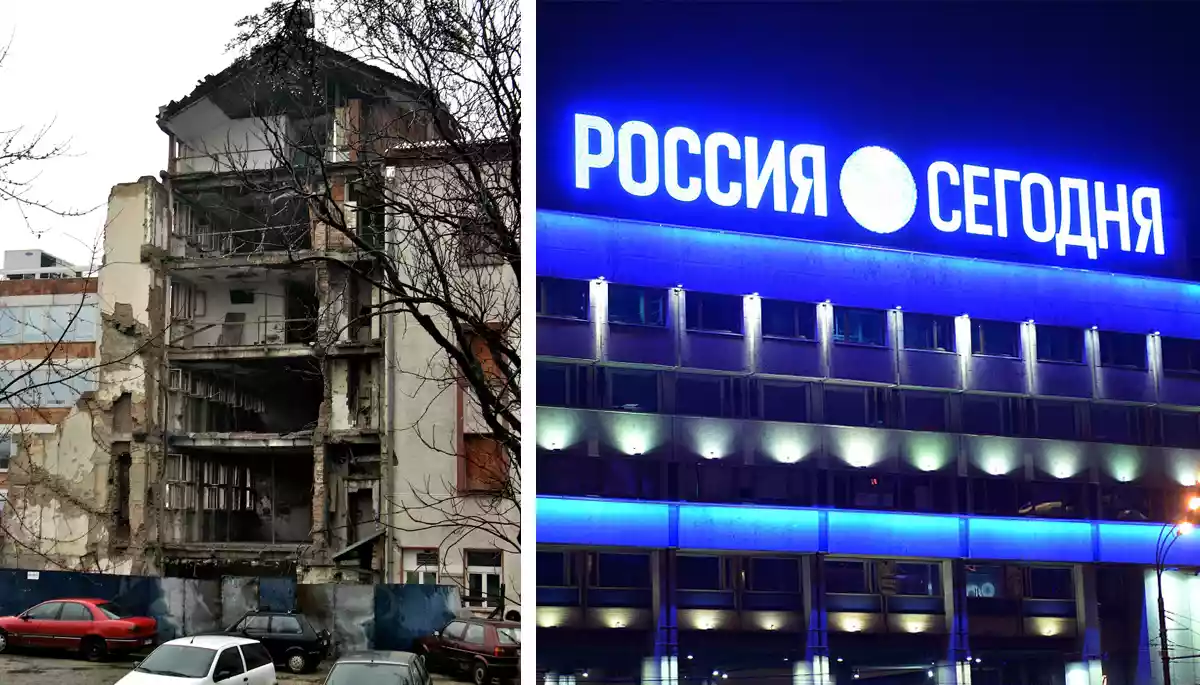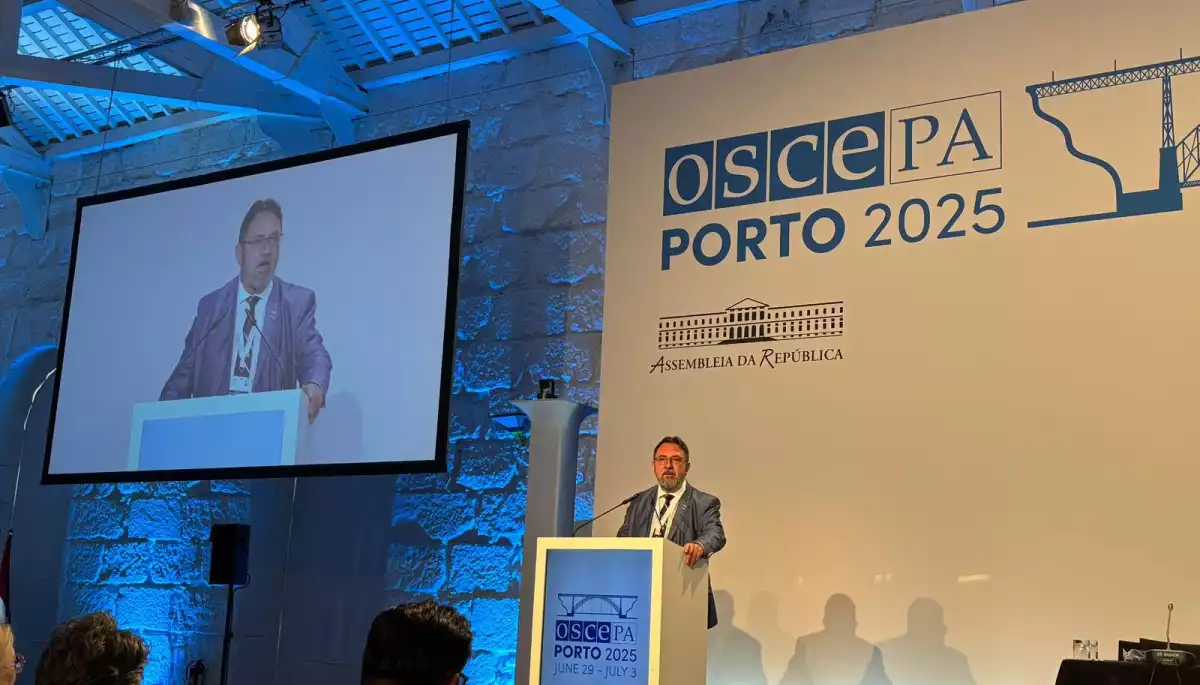
RIA News and others are in the crosshairs: is it legal?


Persecution, torture, and killing of journalists are abhorrent and must be stopped, or Safety of all journalists who freely report on the course of conflicts is essential for the world to understand the reality and facts of the ongoing war, etc.
You can often find such and other theses in international and national legal documents. It underscores journalists’ importance, status, and safety during armed conflict or other volatile situations. Numerous organizations have been created to support the activities of journalists and monitor compliance with all possible security principles by anyone or anything: states, other organizations, international institutions at the UN level, etc.
However, …
It has happened more than once in history.
Strike on Radio and Television of Serbia, RTS (Yugoslavia)
The state broadcaster of Serbia - Radio and Television of Serbia, RTS (1992-2006), was the primary news source and information for the Serbian population during the 1990s. In particular, RTS actively supported the government of Serbia and its policies, including its involvement in the wars in Yugoslavia. The content presented on RTS at this time was vividly nationalist. The media often depicted Serbs as victims of aggression and downplayed or denied reports of atrocities committed by the Serbian army. For example, the network broadcasts statements from Serbian leaders such as Slobodan Milošević, who called for the defense of Serbs in Croatia and Bosnia and denied accusations of war crimes committed by Serbian forces.
On April 24th, 1999, NATO launched two Tomahawk missiles at the building of the Radio and Television of Serbia in Belgrade. The building was partially destroyed, 16 people died, and dozens were trapped under the rubble for a long time. Several other attacks were also carried out on other objects belonging to RTS, such as radio and television towers, transmitters, etc. NATO justified its strike by stating that:
- it was carried out to disrupt command and control, sever communication networks of the Yugoslav armed forces, which according to NATO intelligence, were using RTS networks for military purposes, and
- RTS building was a dual-use object, and those working inside made an important contribution to the propaganda war, organizing a campaign against the population of Kosovo. In other words, RTS media content supported military operations, undermining the morale of opposing forces and the civilian population in Kosovo.
The International Criminal Tribunal for the former Yugoslavia (ICTY) noted that the civilian television network was indeed part of the overall military communication system of the Serbian government and therefore constituted a legitimate target for military operations. However, it emphasized that military command should still consider the international principles regarding the status and protection of journalists during the armed conflict before launching such an attack (spoiler alert: they are civilians and cannot be military targets, but there are nuances regarding the latter).
Or,
Strike on Voice of Sharia (Afghanistan)
Voice of Sharia was the primary tool of the Taliban in conducting an information war against the US and its allies. The radio station actively produced content supporting the extremist ideology of the Taliban and rejecting Western values and beliefs, calling on insurgents to commit violence and transmitting various threats, especially towards the US. Voice of Sharia could be heard in any, even the most remote corner of Afghanistan, and was essentially the only source of news and information for many Afghans living in areas controlled by the Taliban.
On October 8, 2001, US and allied forces launched airstrikes on the main office of Voice of Sharia in Kabul, effectively ending its operation. The US claimed the Voice of Sharia office was a legitimate military target. The station was not only actively involved in the information war but was also an instrument for recruiting people into the ranks of the Taliban. US military officials also emphasized that they took all possible measures to minimize harm to civilians, including distributing leaflets warning of the impending strike only to the station’s transmitter, not the entire building. However, the position of the US came under a barrage of criticism from some journalistic organizations who believed that such a strike could severely impact press freedom and the right to information in Afghanistan.
Disputes over the strike’s legality under international law continue to this day.
On the one hand, there are claims of violations of the principles of proportionality of harm and military advantage. And on the other, a noticeable majority insists on the legitimacy of the strike because the Taliban used the radio station to coordinate their military operations, recruit recruits, and spread propaganda.
The US and its allies’ strikes on media in Serbia and Afghanistan were not the first of their kind in history. During World War II, in 1944, Allied forces struck a radio station in Berlin that broadcasted Third Reich rhetoric. During the Persian Gulf War, the US military targeted several media outlets, including Iraqi TV, in 1991. According to the US, insurgents were used to revealing details of their opponents' military operations, exposing them to danger, and coordinating the rebels’ operations. In the Iraq War, the US struck the Al Jazeera media building in Baghdad in 2003, allegedly broadcasting extremist rhetoric from Saddam Hussein's regime. All of the mentioned media were attacked because they were propagandists and spreaders of hostility or were used by one of the conflict's sides to achieve victory in the information war and on the battlefield.
International law currently does not contain categorical formulations regarding the balance between the proportionality and legality of strikes on the media. However, war is not waged in a vacuum, and it is impossible always to maintain that ideal neutral position that all international conventions and treaties call for. Both, the issue of complying with the norms of international law and the problem of supporting one position or another in the conflict without crossing the line into propaganda and biased reporting does not have a clear answer.
Nevertheless, international law has repeatedly emphasized that any information and calls for committing crimes are unacceptable.
Behind every piece of information or call to action is not just a label, media outlet, or institution but a person - as the ideologue and leader of all processes. Let's recall the case in Nuremberg against Julius Streicher, founder and editor of the Der Stürmer (ENG. Stormtrooper) - primary tool of ideological extermination of Jews in the Third Reich. Also the famous Media case within the International Criminal Tribunal for Rwanda (ICTR). Case issued against Jean-Bosco Barayagwiza, chairman of the executive committee of Radio Télévision Libre des Mille Collines (RTML), Ferdinand Nahimana, founder of the said radio, and Hassan Ngeze, founder, owner and editor of Kangura, - all of them convicted of incitement to genocide and other war crimes, crimes against humanity. By the way, the activities of media professionals in the events of the genocide in Rwanda were defined by NATO as such that if the media is used to incite crimes, as in Rwanda, then it is a legitimate target.
In other words, media and/or individual journalists can and are capable of playing key roles in fueling and inciting even greater violence during conflicts. And thanks to such activity, they can quickly become legitimate targets for the military during armed conflicts.
And what position does international law take on this?
Regarding this, the norms of the international law state that journalists and other media representatives cannot be military targets during wartime operations. However, there are doubts in practice, especially today when war is not just happening in fields and forests. International law allows for the possibility that a civilian object may become military and be targeted - it all depends on whether such an object provides effective contribution to military action and whether its destruction, neutralization, or capture will provide definite contribution to the military action.
If the first condition is somewhat understandable since objects that offer an effective contribution are directly related to the armed forces, or their location makes sense for military operations, exposing them to the risk of attack. One more thing that shoulb be noted - all these norms were written back in the 1950s when the methods and tools of warfare were simple, meaning two warring parties with guns, planes, and tanks in the field, air, or forests. Today, the toolkit of war has dramatically expanded - it has long been taking place outside of simple ones - to the informational, cultural, or economical spaces with its own tools.
But regarding the term certain military advantage, there is only one condition - unlawfully carrying out an attack that results in only potential or indeterminate advantages, and those who carry it out must consider all circumstances, and in case of doubt - the safety of the civilian population. At first glance, everything is straightforward.
However, there are significant doubts about understanding the term potential or indeterminate advantages, as it is impossible to predict all the consequences of such an attack on the one hand and the other - how to compare definite advantages with effective contribution in the context of a war that is being fought, for example, on the internet or in the media?
And what’s wrong with Russian media?
Nonetheless, Russia’s aggression against Ukraine noticeably affects the established norms of international law and their perception. Numerous media outlets (which still operate on the territory of Russia) are information agents of the Kremlin, mouthpieces of Putin’s terrorist regime propaganda, filled with the language of hostility, and most importantly, the primary tool of Russia in conducting information warfare.
The day has come when we all recognize that words, cameras, photographs, the internet, and information, in general, have become another type of weapon, another type of Armed Forces. This weapon can be used for good or bad. It is a weapon that has participated in events in our country in different years, both in defeats and victories.
Sergei Shoigu, Minister of Defense of the Russian Federation
These inspiring words were spoken by the Russian Defense Minister in 2015 during the annual ceremony of awarding Russian journalists the MEDIA-ACE 2015 for their significant contribution to strengthening the positive image of the Russian Armed Forces. Among the permanent nominees are RIA News, Channel First (Pervyy kanal), Zvezda, TASS News, Komsomolskaya Pravda, RT (Russia Today), Russia24, and many others.
In 2021, Shoigu noted the “special” merits of journalists during the operation in Karabakh and the conflict in Syria in portraying Russian military personnel as peacekeepers, which contributed to restoring peace and justice in these territories. Awards are given to journalists who skillfully whitewash the Russian army and portray its activities from the brightest and most pleasant angles.
It is typically the domain of military correspondents. In the conflict in Ukraine, amid the Russian military’s position as “peacekeepers”, they have focused on providing real-time coverage of everything happening on the front lines and in the rear, down to the smallest details. However, this information is provided using only the Kremlin's official rhetoric - in other words, not Russian forces, but “peacekeepers” or “liberators”; not Ukrainians, but “satanists” or “ukrofascists (Ukrainian fascists)”; and everything that happens is “genocide of the Russian people in Ukraine under the leadership of the Kyiv regime”, and so on. Military correspondents are essentially informant-helpers for the Russian armed forces, particularly regarding target selection, the effectiveness of strikes, the location of strategic enemy forces, and their quantity and quality - all of which unquestionably give certain advantages to Russian troops on the battlefield. Many military correspondents collaborate with the Russian Ministry of Defense or other Russian special services. Among them are Semen Pegov (author of the WarGonzo Telegram channel), Alexander Kots, Vladlen Tatarsky, Yuriy Kotenok (author of the Voenkor Kotenok Telegram channel), and many others who collaborate with the General Staff of the Armed Forces of the Russian Federation’s Main Directorate (GRU).
Russia also has powerful information forces in the rear, among whose main tasks at present are to whiten Russia in general and specifically its army, to create an image of a weak and demoralized enemy as a counterbalance to the powerful “second army of the world”, and to attract and recruit volunteers to the ranks of the Russian Armed Forces. Leading information agencies mentioned earlier and their leaders/ideologues/experts - Olga Skabeeva, Yevgeny Popov, Margarita Simonyan, Vladimir Solovyov, Dmitry Kiselyov, Andrey Krasovsky (btw, he was sentenced in absentia to 5 years in prison for public calls for genocide) - are involved in this. According to various sources, many also work directly with the Russian Ministry of Defense, GRU, or the Office of the President of the Russian Federation - as evidenced by numerous awards propagandists have repeatedly received for specific “merits”.
Other journalists in Russia amplify their work - they produce stories that directly call for the commission of war crimes and other violations of the law on the territory of Ukraine.
Russian society's weak critical thinking skills open up significant opportunities for Russian journalism. Illusory universes are created in the interests of Putin. Other members of the senior political leadership of the Russian Federation with a distorted system of values, beliefs, and views on internationally recognized values of peace and sustainable social development.
Freedom of speech no longer exists in Russia - it has become an instrument of manipulation and aggression, and the media is another means of waging war in the hands of Putin.
So what are the conclusions?
However, are the activities and rhetoric of Russian media and its so-called journalists guilty of inciting genocide and committing other crimes - definitely yes. Whether it makes them legitimate targets for military action - given the cases of strikes on the media and the ambiguity of international law - it is quite possible that cotton in the offices of Russian media could become a reality.
PIDHORNA Daryna,
lawyer of the NGO Regional Center for Human Rights
a member of the Expert Network Crimean Platform











